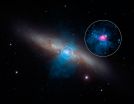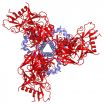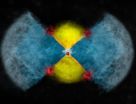(Press-News.org) Astronomers working with NASA's Nuclear Spectroscopic Telescope Array (NuSTAR), led by Caltech's Fiona Harrison, have found a pulsating dead star beaming with the energy of about 10 million suns. The object, previously thought to be a black hole because it is so powerful, is in fact a pulsar—the incredibly dense rotating remains of a star.
"This compact little stellar remnant is a real powerhouse. We've never seen anything quite like it," says Harrison, NuSTAR's principal investigator and the Benjamin M. Rosen Professor of Physics at Caltech. "We all thought an object with that much energy had to be a black hole."
Dom Walton, a postdoctoral scholar at Caltech who works with NuSTAR data, says that with its extreme energy, this pulsar takes the top prize in the weirdness category. Pulsars are typically between one and two times the mass of the sun. This new pulsar presumably falls in that same range but shines about 100 times brighter than theory suggests something of its mass should be able to.
"We've never seen a pulsar even close to being this bright," Walton says. "Honestly, we don't know how this happens, and theorists will be chewing on it for a long time." Besides being weird, the finding will help scientists better understand a class of very bright X-ray sources, called ultraluminous X-ray sources (ULXs).
Harrison, Walton, and their colleagues describe NuSTAR's detection of this first ultraluminous pulsar in a paper that appears in the current issue of Nature.
"This was certainly an unexpected discovery," says Harrison. "In fact, we were looking for something else entirely when we found this."
Earlier this year, astronomers in London detected a spectacular, once-in-a-century supernova (dubbed SN2014J) in a relatively nearby galaxy known as Messier 82 (M82), or the Cigar Galaxy, 12 million light-years away. Because of the rarity of that event, telescopes around the world and in space adjusted their gaze to study the aftermath of the explosion in detail.
Besides the supernova, M82 harbors a number of other ULXs. When Matteo Bachetti of the Université de Toulouse in France, the lead author of this new paper, took a closer look at these ULXs in NuSTAR's data, he discovered that something in the galaxy was pulsing, or flashing light.
"That was a big surprise," Harrison says. "For decades everybody has thought these ultraluminous X-ray sources had to be black holes. But black holes don't have a way to create this pulsing."
But pulsars do. They are like giant magnets that emit radiation from their magnetic poles. As they rotate, an outside observer with an X-ray telescope, situated at the right angle, would see flashes of powerful light as the beam swept periodically across the observer's field of view, like a lighthouse beacon.
The reason most astronomers had assumed black holes were powering ULXs is that these X-ray sources are so incredibly bright. Black holes can be anywhere from 10 to billions of times the mass of the sun, making their gravitational tug much stronger than that of a pulsar. As matter falls onto the black hole the gravitational energy turns it to heat, which creates X-ray light. The bigger the black hole, the more energy there is to make the object shine.
Surprised to see the flashes coming from M82, the NuSTAR team checked and rechecked the data. The flashes were really there, with a pulse showing up every 1.37 seconds.
The next step was to figure out which X-ray source was producing the flashes. Walton and several other Caltech researchers analyzed the data from NuSTAR and a second NASA X-ray telescope, Chandra, to rule out about 25 different X-ray sources, finally settling on a ULX known as M82X-2 as the source of the flashes.
With the pulsar and its location within M82 identified, there are still many questions left to answer. It is many times higher than the Eddington limit, a basic physics guideline that sets an upper limit on the brightness that an object of a given mass should be able to achieve.
"This is the most extreme violation of that limit that we've ever seen," says Walton. "We have known that things can go above that by a small amount, but this blows that limit away."
NuSTAR is particularly well-suited to make discoveries like this one. Not only does the space telescope see high-energy X-rays, but it sees them in a unique way. Rather than snapping images the way that your cell-phone camera does—by integrating the light such that images blur if you move—NuSTAR detects individual particles of X-ray light and marks when they are measured. That allows the team to do timing analyses and, in this case, to see that the light from the ULX was coming in pulses.
Now that the NuSTAR team has shown that this ULX is a pulsar, Harrison points out that many other known ULXs may in fact be pulsars as well. "Everybody had assumed all of these sources were black holes," she says. "Now I think people have to go back to the drawing board and decide whether that's really true. This could just be a very unique, strange object, or it could be that they're not that uncommon. We just don't know. We need more observations to see if other ULXs are pulsing."
INFORMATION:
Along with Harrison and Walton, additional Caltech authors on the paper, "An Ultraluminous X-ray Source Powered by An Accreting Neutron Star," are postdoctoral scholars Felix Fürst, and Shriharsh Tendulkar; research scientists Brian W. Grefenstette and Vikram Rana; and Shri Kulkarni, the John D. and Catherine T. MacArthur Professor of Astronomy and Planetary Science and director of the Caltech Optical Observatories. The work was supported by NASA and made use of data supplied by the UK Swift Science Data Centre at the University of Leicester.
ATLANTA – October 08, 2014 – A study from American Cancer Society researchers finds the increased risk of premature death associated with a higher body mass index (BMI) is similar for African Americans and whites, in contrast to previous, smaller studies that indicated the association may be weaker for African Americans. The study, published in the open-access, online publication PLOS ONE, finds that among never smokers without prevalent disease, overweight and obesity are strongly associated with subsequent risk of mortality in every race. The authors say ...
New Haven, Conn. - HIV is adept at eluding immune system responses because the protein it uses to infect cells is constantly changing.
Now a team of researchers including scientists from Yale have stripped the cloak from this master of disguise, providing a high resolution image of this surface spike protein and monitoring how it constantly changes its shape, information that suggests new ways to attack the virus through drugs and vaccines.
In two papers published simultaneously online Oct. 8 in the journals Science and Nature. team of researchers led by scientists ...
Highly-detailed radio-telescope images have pinpointed the locations where a stellar explosion called a nova emitted gamma rays, the most energetic form of electromagnetic waves. The discovery revealed a probable mechanism for the gamma-ray emissions, which mystified astronomers when first observed in 2012.
"We not only found where the gamma rays came from, but also got a look at a previously-unseen scenario that may be common in other nova explosions," said Laura Chomiuk, of Michigan State University.
A nova occurs when a dense white dwarf star pulls material onto ...
New research has illuminated the movement and complete structure of the spikes on HIV that the virus uses to bind to the cells it infects. This research, led by scientists at the National Institutes of Health, Weill Cornell Medical College and Yale University School of Medicine, could help advance efforts to develop HIV vaccines and treatments.
Three sets of a pair of molecules called gp120 and gp41 constitute each HIV spike, which adopts different configurations before and after the virus fuses with a cell. The atomic-level structures of pre-fusion gp120 and post-fusion ...
NEW YORK — (October 8, 2014) -- Researchers at Weill Cornell Medical College have developed technologies that allow investigators, for the first time, to watch what they call the "dance" of HIV proteins on the virus' surface, which may contribute to how it infects human immune cells. Their discovery is described in the Oct. 8 issue of Science, and is also a part of a study published the same day in Nature.
The new technology platform opens new possibilities for devising an approach to prevent HIV infection, says Dr. Scott Blanchard, an associate professor of physiology ...
Astronomers have discovered a black hole that is consuming gas from a nearby star 10 times faster than previously thought possible. The black hole—known as P13—lies on the outskirts of the galaxy NGC7793 about 12 million light years from Earth and is ingesting a weight equivalent to 100 billion billion hot dogs every minute.
The discovery was published today in the journal Nature.
International Centre for Radio Astronomy Research astronomer Dr Roberto Soria, who is based at ICRAR's Curtin University node, said that as gas falls towards a black hole it gets ...
An international team of astronomers has been able to see into the heart of an exploding star, by combining data from telescopes that are hundreds or even thousands of kilometres apart. Their results are published at 18:00 hours on Oct 8 2014 in the journal Nature.
Highly-detailed images produced using radio telescopes from across Europe and America have pinpointed the locations where a stellar explosion (called a nova), emitted gamma rays (extremely high energy radiation). The discovery revealed how the gamma-ray emissions are produced, something which mystified astronomers ...
This news release is available in German. A team of ETH Zurich researchers led by professors Nenad Ban and Ruedi Aebersold have studied the highly complex molecular structure of mitoribosomes, which are the ribosomes of mitochondria. Ribosomes are found in the cells of all living organisms. However, higher organisms (eukaryotes), which include fungi, plants, animals and humans, contain much more complex ribosomes than bacteria. In eukaryotes, ribosomes can also be divided into two types: those in the cytosol – which comprises the majority of the cell – and ...
(PHILADELPHIA) – Transfer RNAs (tRNAs) are ancient workhorse molecules and part of the cellular process that creates the proteins, critical building blocks of life that keep a cell running smoothly. A new discovery suggests that the number of human genomic loci that might be coding for tRNAs is nearly double what is currently known. Most of the newly identified loci resemble the sequences of mitochondrial tRNAs suggesting unexpected new links between the human nuclear and mitochondrial genomes, links that are not currently understood.
Transfer RNAs (tRNAs) represent ...
CORVALLIS, Ore. – A study of the removal of two dams in Oregon suggests that rivers can return surprisingly fast to a condition close to their natural state, both physically and biologically, and that the biological recovery might outpace the physical recovery.
The analysis, published by researchers from Oregon State University in the journal PLOS One, examined portions of two rivers – the Calapooia River and Rogue River. It illustrated how rapidly rivers can recover, both from the long-term impact of the dam and from the short-term impact of releasing stored ...




